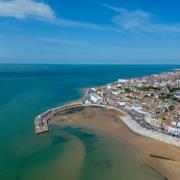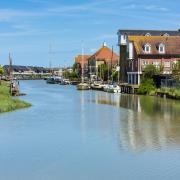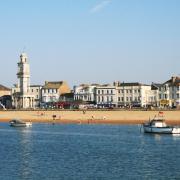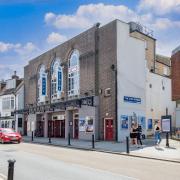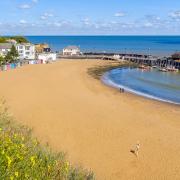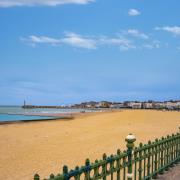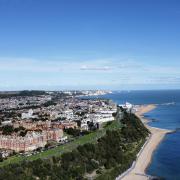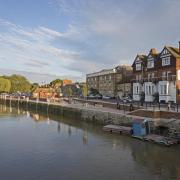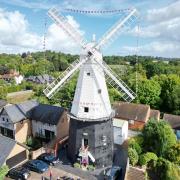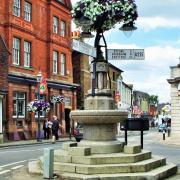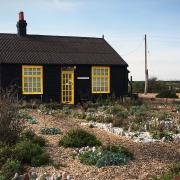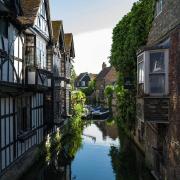This bustling, historic town and major ferry port facing France across the narrowest part of the English Channel makes a fascinating place to visit. Here are just 10 of the reasons why....
This bustling, historic town and major ferry port facing France across the narrowest part of the English Channel makes a fascinating place to visit ....
10 reasons why...
Beer, folk and flour Crabble Corn Mill on the River Dour is one of the finest working examples of a Georgian watermill in Europe, rescued from demolition and opened to the public in 1990. Kent's only working watermill, it has six floors of water-powered machinery. A working museum, it uses displays to show Victorian and Georgian engineering methods and produces Crabble Mill flour that you can buy in the Mill Shop. Look out for the annual Beer Festival (27 and 28 May), acoustic music and quiz nights, plus art and photographic exhibitions. Caf� and licensed bar.
Roman murals and boilers The Roman Painted House the remains of a Roman fort wall and bastion, is preserved complete with 400 sq ft of murals. See the component parts of the underfloor heating system, plus 30 display panels that tell the story of Roman Dover. The house, which formed part of a mansion for travellers crossing the Channel, was demolished in AD 270 to facilitate the construction of a larger fort. Three of its main rooms were buried, largely intact.
Defences, beauty and walks Whinless Down is the gateway to an AONB, with butterflies and wildflowers on ancient chalk grasslands, walking routes, orienteering and Tree Trail courses. At Western Heights there are three waymarked walking routes and old fortifications, including the Drop Redoubt Fort and the Grand Shaft. Samphire Hoe is great for walks and fishing from the sea wall.
Castles, kings and secret tunnels Dover Castle offers secret wartime tunnels that probe deep into the White Cliffs. See where Second World War service personnel worked, slept and planned campaigns and strategies,the underground hospital, wartime plotting room and telecommunications centre. The castle’s Great Tower dates from the 1100s and brings alive the times of King Henry 11. Don’t miss the Roman lighthouse and Saxon church, the medieval tunnels and the Princess of Wales’ Royal Regiment Museum. From June you can witness the ‘evacuation of Dunkirk visitors' experience’.
Whales and flagstones of historyConnaught Park, in town, has a childrens’ play area, tennis courts, mini-football pitch and small-bird aviary: note the curious archway formed by the jawbones of a whale. Kearnsey Abbey is named after a now-demolished 1820s mansion house and its only remaining part, the Billiard Room, is used as a tea room; there’s a lake with wildlife, plant gardens, plus play and bbq areas. Russell Gardens has an 18-hole putting area, four grass tennis courts and a play area. Adjoining this is Bushy Ruff, a country park with a lake where you can see ducks, swans and moorhens. On the banks of the River Dour is Pencester Gardens, near the town centre, with lawns, skate park, play area, a bandstand and Millennium Path, made up of 100 flagstones, each commemorating an event in Dover’s history.
Retail therapy – Dover style De Bradelia Wharf is an exciting fashion outlet centre in the waterfront location of Dover Marina where you’ll find top-brand fashion, furnishings and homeware, and get savings of up to 70 per cent. Car park and Waves coffee shop. Charlton Shopping Centre, also with a car park, is in the town centre and has a host of independent stores, plus a striking glass-domed atrium. Dover Saturday Market is held every week on Market Square, where you can buy local farm-fresh meat, bread, fruit, vegetables and flowers, as well as jewellery.
Dover is on the east coast between Dover and Deal, 75 miles from London and 15 miles from Canterbury. By road from London, follow the M20 leading off the M25, then take the A20 to Dover. Dover Priory station has twice-hourly trains to London and there are coach links to London and the rest of Kent, in addition to buses. Satnav postcode: CT16 1DL
Boat tours and fishing tripsDover White Cliffs tours operates the Southern Queen, which picks you up from the marina and takes you on a 40-minute guided tour of Dover. A bus continues the tour to Eastern and Western Heights, where you can get out and stretch your legs, then brings you back to the marina or town. Coker Sea Fishing Charters run two boats: the Royal Charlotte and Portia, licensed and insured for 12 people: rods, tackle and bait for fishing are provided. Fire Fox Fishing Charters has a fully licensed charter boat for sea fishing.
Vintage wheels and Land Army LadiesWheel amaze you! is Dover Transport Museum's motto. It has displays of more than 50 vehicles, many in period street scenes, dating from 1914 to 1970, and a working model railway. See The Vintage Garage, May’s Cycle Shop and the Maritime Rooms, all illustrating the history of Dover harbour and its train ferries. The Land Army museum gives a fascinating insight into life for women doing Land Army work in the Second World War: read personal letters from ex-land army ladies, and view authentic uniforms and information.
Dover through the centuriesDover Museum and Bronze Age Boat Gallery has exhibits thatshow the town’s history from prehistoric times to 1990, One of the finest bronze-age displays in the UK, plus Roman glass and pottery, Anglo-Saxon finds, displays showing the history of the castle, medieval and Victorian development of the town, as well as Dover’s pivotal role in both World Wars.
There’ll be Bluebirds over . . . The White Cliffs, owned by the National Trust, is the coastline feature made famous by Dame Vera Lynn’s wartime anthem. You can see rare flora and fauna and take clifftop walks that will give you stunning views of the Channel: on a clear day, you can even see the French coast. Gateway to the White Cliffs Visitor Centre has information on the history and plant life particular to this grassland-on-chalk landscape. Self-guided and guided walks, Tracker Packs, plus a gift shop and caf�. South Foreland Lighthouse on the White Cliffs is the site of Faraday’s pioneering work using electricity in lighthouses and where Marconi did wireless experiments.



